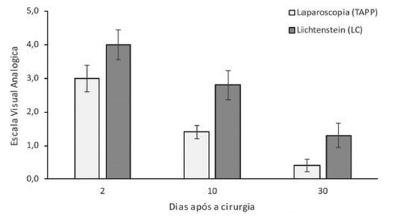ABSTRACT
Background:
There are several surgical treatment options for inguinal hernia; however, there is no consensus on the literature identifying which surgical technique promotes less postoperative pain.
Aim:
To compare the intensity of postoperative pain between the surgical techniques Lichtenstein and transabdominal pre-peritoneal laparoscopy for the treatment of unilateral primary inguinal hernia.
Methods:
Were included 60 patients, of which 30 were operated through the Lichtenstein technique and 30 patients through the transabdominal pre-peritoneal laparoscopy. The pain levels were evaluated through the analogue visual scale for 2, 10 and 30 days after the surgery. Additionally, the recurrence rate and the presence of chronic pain and paresthesia were evaluated 12 months after the surgery.
Results:
Overall, the data analysis showed significant differences on pain levels between the surgical techniques. There were no significant differences between the pain levels for day 2. However, for 10 and 30 days after the surgery, the pain levels were significantly lower for the patients operated through the transabdominal pre-peritoneal laparoscopy technique compared to the Lichtenstein technique. Furthermore, despite no recurrent hernias for both surgical techniques, 32 % of patients operated through the Lichtenstein technique reported chronic pain and paresthesia 12 months after the surgery, compared with 3,6% of patients operated through the transabdominal pre-peritoneal laparoscopy technique.
Conclusion:
There are differences between the surgical techniques, with the transabdominal pre-peritoneal laparoscopy procedure promoting significantly lower postoperative pain (10 and 30 days) and chronic pain (12 months) compared to the Lichtenstein procedure.
HEADINGS
Pain, postoperative; Visual analog scale; Hernia, inguinal; Laparoscopy

